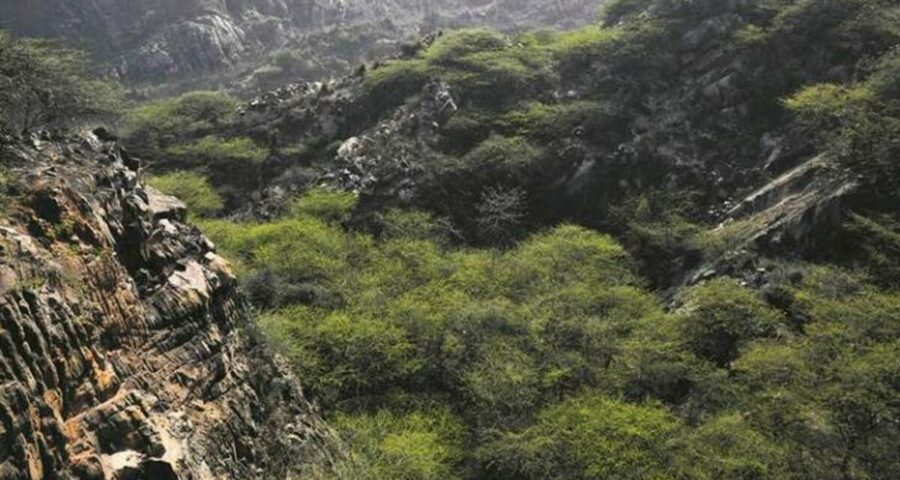Report alleges use of forest land parcels for non-forest purposes in Aravalli, Shivalik hill areas.
The CAG has detected parcels of forest land being used for non-forest purposes at several places in Aravalli and Shivalik Hill areas in Haryana. In its report tabled in the Assembly Tuesday, the CAG has insisted that “the delicate ecology under the forest cover in Aravalli and Shivalik range constantly suffered due to encroachments and unauthorised activities”. The report alleged “the government of Haryana was ineffective in checking illegal mining, controlling offenders and expenditure incurred on surveillance”.
Haryana Principal Chief Conservator of Forests (PCCF) V S Tanwar told The Indian Express on Wednesday that they are examining the observations of the CAG report. “We have also sought report from the officers concerned who are looking after the areas of Aravalli and Shivalik Hill areas in this regard,” Tanwar added.
The Aravallis of Haryana falls in seven districts: Gurugram, Mewat, Faridabad, Palwal, Mahendragarh, Rewari and Bhiwani. “Ecological degradation in the Aravalli region is in alarming situation due to increasing population of human and cattle, injudicious use of natural resources, unscientific mining, uncontrolled grazing and felling of trees,” the report mentioned.
The report stated, “The National Capital Region, including Gurugram/Faridabad, has witnessed exponential growth on the limited natural resources. Resultantly, the Aravalli region remains ecologically, economically and socially backward in comparison with the other parts of the state.”
The Shivalik region in Haryana is spread over 3,514 square kms in districts of Ambala, Panchkula and Yamunanagar. “In less than half a century, burgeoning population of human and livestock have stressed the natural resources of Shivalik, thereby threatening the survival of its flora and fauna,” the CAG report stated.
In its report, the CAG auditors have mentioned six sites where they “noticed encroachments on forest land due to weaknesses in exercising controls by the forest department”. They highlighted how a religious sect carried out construction activities on forest land at Bir Ghaggar (Panchkula) between 2006 and 2009. The sect had requested the forest department to divert 100 acres of protected forest land for setting up a satsang centre there. The permission was granted for diversion of land for setting up satsang centre in January 1998 subject to the conditions that legal status of forest land shall remain unchanged and the forest land diverted would be utilised only for plantation of trees and no construction would be undertaken in the area. However, the report claims that the construction activities were carried out “in violation of the terms and conditions of lease agreement”.
The report stated, “Due to encroachment on 35 acre land, the forest department and the sect executed a lease agreement for 28 years for 65 acres of land in November 2009. Subsequently, possession of additional 19.50 acre (total 84.50 acre) land was also given by April 2011 after getting the land freed from encroachment. As per forest (conservation) rules and guidelines, the lease was to be terminated and sanction was to be cancelled and possession of the land was to be taken by the forest department.”
In another instance, according to the report, forest land in industrial estate Bawal (Rewari) was found under encroachment and large factories were built on this land. The auditors found 2.42 acres of land in Rao-Majra village (Ambala ) which was recorded as protected forest in the records but was being used by farmers for agriculture purposes. “This was tantamount to encroachment of forest land,” the CAG report said. In Narnaul range, pakka structures were constructed at Mukundpura village and adjoining dhanis at six sites. In a separate instance, the auditors observed that in Nuh’s Jhir village (a specified area of Aravalli range), pakka structures were constructed by the residents on forest land and had been living illegally for the past seven-eight years which indicates that “the department was not aware of encroachment on the forest land and had not done watch and ward of the forest area to protect it from illegal activities”.
According to the report, the CAG auditors had sought comments of Haryana’s forest department in November 2019 but “their reply was awaited” (till September 2020).
To assess the effectiveness of forest department in protecting forest area under hilly zones from illegal mining and encroachments, the CAG auditors had checked the records in the office of PCCF and eight out of 10 divisional offices located in Aravalli and Shivalik areas for a period of 2015-19. The records were checked during July 2018 to April 2019. The auditors claim that the possession of 170.74 acre land was not taken for compensatory afforestation at three sites. In another para, the auditors have mentioned that compensatory afforestation was carried out only on 39.07 hectare against the availability of 122.18 hectare land.
“Inadequate watch and ward controls of the department led to illegal mining in forest areas. Delay in taking action against the offenders of forest rules resulted in loss of Rs 2.74 crore. Further, the expenditure of Rs 2.9 crore on salary of protection watchers was not incurred in a transparent manner,” the report mentioned.
Haryana is primarily an agricultural state with almost 80 per cent of its land under cultivation. Out of total 44,212 square kilometres geographical area of the state, only 3.9 per cent is under notified forests. Forestry activities in the state are spread over Shivalik Hill in north, Aravalli hills in south, sand dunes in west and wastelands, saline-alkaline lands and waterlogged sites in the central part of the state.
Source: Read Full Article


